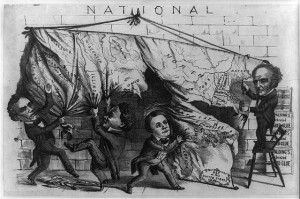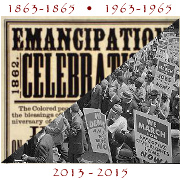Myth-busting and the Civil War: The South turns to federal authority to preserve slavery
Posted September 21st, 2012 by Katrina BrowneCategory: Public History Tags: Battle of Antietam, Battle of Sharpsburg, Drew Gilpin Faust, Dwight Pitcaithley, National Park Service, Southern secession

1860 political cartoon, showing presidential candidates Lincoln, Douglas, Breckinridge, and Bell dividing the country.
This is the second part of Katrina Browne’s reflections on the 150th anniversary commemoration at Antietam this past weekend. The first part, focused on northern myths about the civil war, was entitled “The Emancipation Proclamation: ‘… all the moral grandeur of a bill of lading.’“
Irony. It’s the word that came fast to mind as I sat listening this past weekend to former National Park Service Chief Historian Dwight Pitcaithley as he revealed the following: that in the heated days of late 1860 and early 1861, from just after Lincoln’s election to several weeks after his inauguration, pro-slavery Southern political leaders, while seceding, simultaneously turned to the power of the federal government to try to protect slavery! I was at the 150th anniversary commemoration of the Battle of Antietam/Sharpsburg, and Prof. Pitcaithley was speaking on “Secession as a Constitutional Crisis.”
He explained that in the span of five months, no fewer than 66 constitutional amendments were proposed in Congress to shore up the institution of slavery. To turn to the Constitution was the ultimate turn to federal power in an attempt to enshrine slavery. The case was made primarily based on the 5th amendment’s protection of the right to property. (Interestingly, pro-abolition crusaders were turning to the same clause in the 5th amendment: that no person “shall be deprived of life, liberty, or property, without due process of law” and focusing on liberty rather than property. Ironies abounding.)


